#Object Oriented Systems and C++
Explore tagged Tumblr posts
Text
Should I actually make meaningful posts? Like maybe a few series of computer science related topics?
I would have to contemplate format, but I would take suggestions for topics, try and compile learning resources, subtopics to learn and practice problems
#computer science#embedded systems#linux#linuxposting#arch linux#gcc#c language#programming#python#infosecawareness#cybersecurity#object oriented programming#arduino#raspberry pi#computer building#amd#assembly#code#software#software engineering#debugging#rtfm#documentation#learning#machine learning#artificial intelligence#cryptology#terminal#emacs#vscode
4 notes
·
View notes
Text
Dandelion News - January 1-7
Like these weekly compilations? Tip me at $kaybarr1735 or check out my Dandelion Doodles!
1. Homes built with clay, grass, plastic and glass: How a Caribbean island is shying away from concrete

“[… Clay] traps moisture which then evaporates and pulls heat from the surface as it goes. […] The roof is covered in old recycled advertising banners and piece of a water tank, the other half of which is used to house some of Rahaman-Noronha's fish [… and] multi-coloured glass bottles inset into walls provide an avenue for streams of light and colour.”
2. To Combat Phoenix’s Extreme Heat, a New Program Provides Sustainable Shade

“The neighborhood workshops allow residents to get a shade plan tailored to their community’s needs and identify the locations where officials can plant trees. Meanwhile, the workforce-development side of the program creates the jobs needed to keep the trees alive for generations[….]”
3. Conservation corridors provide hope for Latin America’s felines

“[… S]cience has shown that to maintain healthy populations there needs to be connection between individuals. [… A] protected area that is close to another has more species and more potential for their survival.”
4. Social program cuts tuberculosis cases among Brazil's poorest by more than half

“The decrease [“in TB cases and deaths”] was over 50% in extremely poor people and more than 60% among the Indigenous populations. […] "We know that the program improves access to food [… and healthcare…] and strengthens people's immune defenses as a result.””
5. Geothermal has vast potential to meet the world’s power needs
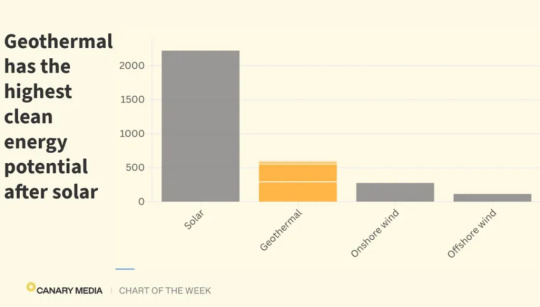
“New geothermal systems could technically provide as much as 600 terawatts of carbon-free power capacity by 2050[…. C]ountries could cost-effectively deploy over 800 GW of geothermal power capacity using technology that’s in development today[….]”
6. New D.C. Catholic archbishop is pro-LGBTQ+ and anti-Trump

“In 2018, he objected to the blaming of gay priests for the clergy sexual abuse crisis, “saying that such abuse was a matter of power, not sexual orientation[….]” “We must disrupt those who portray refugees as enemies [… and] seek to rob our medical care, especially from the poor.””
7. Chesapeake Bay Will Gain New Wildlife Refuge
“The Chesapeake Bay area will have a new wildlife refuge for the first time in a quarter century. […] “This new refuge offers an opportunity to halt and even reverse biodiversity loss in this important place, and in a way that fully integrates and respects the leadership and rights of Indigenous peoples and local communities.””
8. Inside Svalbard seed vault’s critical mission to stop our favourite fruit and veg from going extinct

“[… T]he world’s largest secure seed storage […] sits proudly in a massive former coal mine[….] Right now, there are over 1,331,458 samples of 6,297 crop species. […] “During 2024, 61 seed genebanks deposited 64,331 seed samples, including 21 from institutes that deposited seeds for the first time this year[….]””
9. Medical debt will be erased from credit reports for all Americans under new federal rule

“The rule will affect more than 15 million Americans, raising their credit scores by an estimated average of 20 points. [… S]tates and localities have already utilized American Rescue Plan (ARP) funds to support the elimination of over $1 billion in medical debt for more than 700,000 Americans[….]”
10. 'Forgotten' water harvesting system transforms 'barren wasteland' into thriving farmland
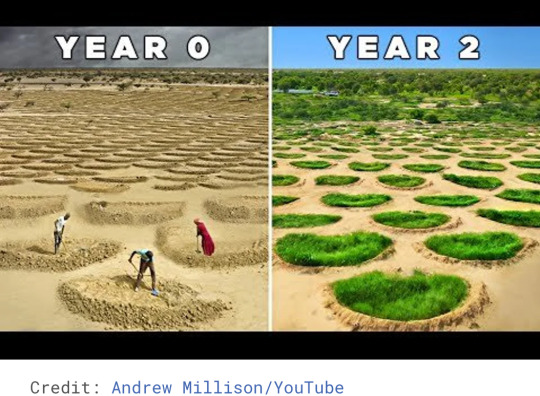
“"The process started with the community-based participatory planning[….]” 10% to 15% of the water will actually soak into the ground to replenish the water table, creating a more sustainable agricultural process.”
December 22-28 news here | (all credit for images and written material can be found at the source linked; I don’t claim credit for anything but curating.)
#hopepunk#good news#recycling#upcycling#climate change#climate action#trees#habitat restoration#habitat#big cats#cats#latin america#brazil#tuberculosis#poverty#geothermal#clean energy#renewableenergy#catholic#lgbt+#lgbt#lgbtq#religion#christianity#wildlife refuge#wildlife#seed saving#seed bank#medical debt#anti capitalism
309 notes
·
View notes
Text
Cancelled Missions/Station: Manned Orbital Research Laboratory (MORL)

This was a study initiated in 1962 for space stations designs using the Gemini Spacecraft and later on the Apollo CSM. Boeing and Douglas received Phase I contracts in June 1964.


MORL/S-IVB Concept
"A 5 metric ton 'dry' space station, launched by Saturn IB, with Gemini or Apollo being used for crew rotation. The 6.5 meter diameter and 12.6 meter long station included a docking adapter, hangar section, airlock, and a dual-place centrifuge. Douglas was selected by NASA LaRC for further Phase 2 and 3 studies in 1963 to 1966. Although MORL was NASA's 'baseline station' during this period, it was dropped by the late 1960's in preference to the more capable station that would become Skylab.



Different docking concepts studied.
The Manned Orbital Research Laboratory was the brainchild of Carl M Houson and Allen C. Gilbert, two engineers at Douglas. In 1963 they proposed a Mini Space Station using existing hardware, to be launched by 1965. A Titan II or Atlas would be launched with a payload of control system, docking adapter and hangar module. The visiting crew would use the payload to transform the empty fuel tank of the last stage of the rocket into pressurized habitat (a so-called 'wet' space station). Provisions were available for 4 astronauts for a 100 day stay. Crew members would arrive two at a time aboard Gemini spacecraft. Equipment included a two-place centrifuge for the astronauts to readapt to gravity before their return to earth.

An early MORL concert. Artwork by Gordon Phillips.


In June 1964 Boeing and Douglas received Phase I contracts for further refinement of MORL station designs. The recommended concept was now for a 13.5 metric ton 'dry' space station, launched by Saturn IB, with Gemini or Apollo being used for crew rotation. The 6.5 meter diameter and 12.6 meter long station included a docking adapter, Hangar section, airlock, and a dual-place centrifuge.

"Medium-sized orbiting lab is this Manned Orbital Research Laboratory (MORL) developed for NASA's Langley Lab by Douglas Missiles & Spacecraft Division. The lab which weighs about 35,000 pounds, could maintain 3 to 6 men in orbit for a year.
Orbiting Stations: Stopovers to Space Travel by Irwin Stambler, G.P. Putnam's Sons, 1965."
Douglas was selected by NASA LaRC for further Phase 2 and 3 studies in 1963 to 1966. The major system elements of the baseline that emerged included:
A 660-cm-diameter laboratory launched by the Saturn IB into a 370-km orbit inclined at 28.72 degrees to the equator
A Saturn IB launched Apollo logistics vehicle, consisting of a modified Apollo command module, a service pack for rendezvous and re-entry propulsion, and a multi-mission module for cargo, experiments, laboratory facility modification, or a spacecraft excursion propulsion system.
Supporting ground systems.
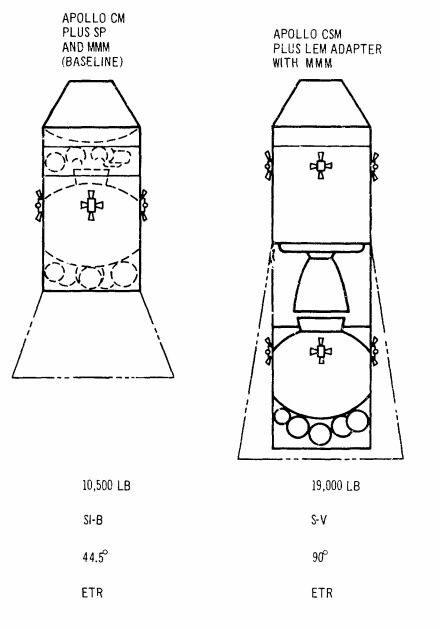

MORL Phase IIb examined the utilization of the MORL for space research in the 1970s. Subcontractors included:
Eclipse-Pioneer Division of Bendix, stabilization and control
Federal Systems Division of IBM, communications, data management, and ground support systems
Hamilton Standard Division of the United Aircraft Corporation, environmental control/life support
Stanford Research Institute, priority analysis of space- related objectives
Bissett-Berman, oceanography
Marine Advisors, oceanography
Aero Services, cartography and photogrammetry
Marquardt, orientation propulsion
TRW, main engine propulsion.
The original MORL program envisioned one or two Saturn IB and three Titan II launches. Crew would be 6 to 9 Astronauts. After each Gemini docked to the MORL at the nose of the adapter, the crew would shut down the Gemini systems, put the spacecraft into hibernation, and transfer by EVA to the MORL airlock. The Gemini would then be moved by a small manipulator to side of the station to clear docking adapter for arrival of the next crew."

"Docking was to have 3 ports, all Nose Dock config, with spacecraft modifications totaling +405 lbs over the baseline Gemini spacecraft (structure beef-up, dock provisions, added retro-rockets, batteries, a data link for rendezvous, temp. control equip. for long-term, unoccupied Gemini storage on-orbit and removal of R&D instruments)."
"Later concepts including docking a Saturn-IB launched space telescope to MORL. At 4 meter diameter and 15 meter long, this would be the same size as the later Hubble Space Telescope. The crew would have to make EVA's to recover the film from the camera.
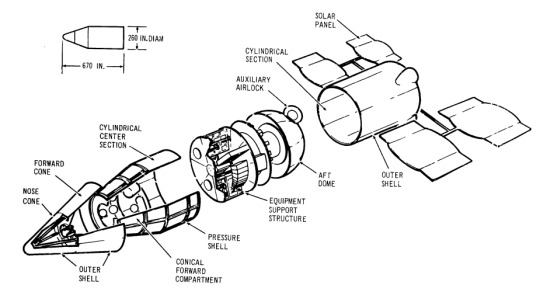

In 1965 Robert Sohn, head of the Technical Requirements Staff, TRW Space Technology Laboratories, proposed a detailed plan for early manned flight to Mars using MORL. The enlarged MORL-derived mission module would house six to eight men and be hurled on a Mars flyby by a single Saturn MLV-V-1 launch. MORL-derived Mars mission modules cropped up in other Douglas Mars studies until superseded by the 10-m diameter Planetary Mission Module in 1969.

MORL/Space Telescope
Why was MORL never launched ?
NASA had a need for a Space Station and MORL was little, easy and cheap. But NASA had more ambitious plans, embodied in the Apollo Applications Orbital Workshop (later called Skylab)."
-information from astronautix.com: link
source, source, source
NARA: 6375661, S66-17592
Posted on Flickr by Numbers Station: link
#Manned Orbital Research Laboratory#MORL#Space Station#Gemini#Gemini Program#Project Gemini#Apollo CSM Block II#Apollo Program#Saturn IB#Saturn I#S-IV#S-IVB#Apollo Applications Program#Cancelled#Study#1962#June#1965#my post
80 notes
·
View notes
Text

hello!
we're worldwide noises. we are a teenaged plural system of indeterminate number, and this is our blog. what's it about? nothing. just like seinfeld! click read more to find out more. warning, we overshare. a lot. read through the full thing to find the thin ice and dni lists respectively. and do not send us donation asks, especially if you're anonymous. we don't know which ones are real, and which ones are not.
there is also a more in-depth post explaining our stances in a simple format.
we (raz/lain, shi/hir pronouns) are white, mesosex, and collectively queer + oriented aroace & genderqueer. also freshly eighteen years old. don't be weird to us.
we are also taken, so please don't flirt with us romantically!!
we're medically diagnosed and/or recognized for: autism, adhd, anxiety, major depressive disorder, (c)ptsd, disruptive mood dysregulation disorder (a precursor to bipolar in most cases), unspecified dissociative disorder, and mild asthma. we also suspect to have idiopathic hypersomnia, dpdr, bpd, hpd, and some narcissistic traits — all with extensive research.
in short, we're fucked.
the part who will front the most & post the most is nec. i'm also the one writing this right now. although, i'm looking for different names for myself. i use shi/hir, vei/vein, and hy/hymn pronouns. i'm a gender non-conforming boygirl, as well as aroacespec and a bi-abro lesbian. and objectum and fictorose, just to add more to the fire.
i'm the one who has the out-system boyfriend... and the one who takes the brunt of our disorders. thanks chat
i'm very autistic about my interests! i love things such as: psychonauts (special interest of 3 years), dandy's world, vocaloid (including utsu-p, pinocchio-p, and the post-traumatic manifesto) (the latter being the theme of this account!), object shows, roblox, pokémon, and more! chances are if you've heard of something somewhat popular yet niche, i've been in the fandom or at least heard of it. share me your playlists! i love playlists, and have around 30+.
however, there are things i don't like. obviously. everyone has dislikes or even hate for things.
fans of vivziepop, dream smp, necrojimbo/analbonez, true crime community, alfred's playhouse, the coffin of andy and leyley, and hoyoverse content are on thin ice. all of these creators have absolutely been shown to be bad or at least questionable people in the past and present, and i'd rather fans of them remain wary. and the true crime community is just weird. there are families of murder victims out there on the internet seeing that shit, come on now. it's just immature and sickening.
and for people i don't want to interact at all,
i don't want these groups to interact with my posts or blog at all: zionists, darkshippers, pro contact for illegal paraphilias, radqueers, anti non-traumagenic systems, and anti-inclus. anti-inclus for me includes terfs (and by extension, radical feminists. y'all's ideology is full of bigotry whether you like it or not), and people who are against contradictory or "weird" labels. my blog is not for you! i will block you if i see you in my notifications. as someone who is queer, not fully traumagenic, a victim of countless horrible things, & more, i don't feel safe around you guys.
now uh. have fun don't die 🔥 here is my umm. dni banner too

#intro post#liomogai#endo safe#pro endo#anti rq#how do i tag this#seriously i've used tumblr for over a year and still don't know how#this is bad
13 notes
·
View notes
Text
Everything Currently Wrong with Typology (And, How We Can Fix That)
Most people within the personality typology community consider typology to only be, at best, something to be relegated to merely being some kind of hobby, or a way to 'break the ice' with people. At worst, it's a waste of time, even a straight-up "pseudoscience". And, in a way, it is all of that. But essentially, the only reason why that's even the case is because we have been doing it all wrong entirely.
1. We're basing things on misinterpretations on top of misinterpretations.
While probably true for personality typology in general, at least to some extent, this is especially true with the Jungian-inspired systems. Nobody seems to know what Jung originally intended, or even care. Of course, there are people that do genuinely try to get an idea of what he had to say about psychological type, but they usually don't go far enough to get a complete picture, and, naturally, they're an exceptional rarity to begin with. The majority of typology enthusiasts never go past Pop-Myers-Briggs -- which is what I call the so-called "MBTI system" (for the record, the MBTI is not a system, it's a psychometric instrument) -- to examine its roots; where it came from. In fact, it's more common for them to look at other Jungian-inspired models, such as the Socionics ones, or C. S. Joseph's system, Objective Personality System, etc.
Why does Classic Jungian (what I call Jung's original system,) get so little attention? Why do so little people bother to take the plunge? I genuinely don't know. Maybe it's the lack of easily accessible resources on it, or -- perhaps more prominently -- maybe everyone just assumes that, since Pop-MB can trace its origins back to Classic Jungian, that they must essentially be the same thing. Well, they aren't. They simply aren't.
The problem started with Isabelle Myers.
When she was coming up with the Myers-Briggs Type Indicator alongside her mother, Katherine Briggs, she, of course, had to read through Jung's theory to make a psychometric assessment meaningfully applicable to it. Unfortunately, though she got most things right, she got at least one thing very, very wrong: the "attitude", or orientation, of any given type's auxiliary function.
This single mistake is much more devastating than one may think at first glance. For the uninformed -- the rest can take it as a refresher, Jung often used the word "attitude" while talking about extroversion* or introversion; while he did use "attitude" to refer to other things, it was not uncommon for the term as he used it to be referring to either. Puzzling as the word choice may be, the reason he chose that particular word is not as important as what role attitude, in this sense of the word, plays in his theory.
With the majority of contemporary typology models, Pop-MB included, we often think of functions themselves as possessing a particular attitude. In fact, we treat Te, for instance, and Ti as being distinct, independent functions due to this notion. However, for Jung, this would be a misunderstanding of how attitude applies to overall type. In his own view -- and I can't stress the importance of this enough -- it is the person's own psyche who has the attitudes, NOT their functions.
What does this mean? It means that, under his model, consciousness is what is either introverted or extroverted, and the functions are then modified by either orientation. This also means that, in essence, there aren't eight functions in total, but only four. Yes, four. But that's something to elaborate upon in a later post. A more relevant-to-this-moment implication is that this means the auxiliary function of each of the sixteen types, as far as Jung is concerned, shares the exact same attitude as the dominant function. This changes everything about a person's function-arrangement, or function "stack" (god i hate that word,) in terms of how it manifests overall in one's personality and personal life. Well... maybe not literally everything, but pretty much so.
Now, I know some skeptics have read the last few paragraphs and are suspicious about the overarching claim being made about the auxiliary's attitude in Classic Jungian. Because I wish to keep this post as concise as possible, I'll present arguments for this being Jung's true intention in a later one. I also do not want to give the impression that I actually agree with Jung here about the auxiliary's attitude: in fact, I personally think functions do, in fact, possess attitudes, as opposed to the psyche, and that the orientation of the auxiliary is independent of whatever the dominant's is. (Edit 03/29/2025: I have since changed my mind on this matter.)
Anyways, if this all started and ended with Myers, the current state of Jungian and Jungian-adjacent typology wouldn't be much of a problem as it is now. Unfortunately, it seems that not only has nobody caught on to her fatal mistake, but that, in fact, the mistakes only compounded. It even got to the point that trained practitioners of analytical psychology (what Jung referred to his psychology as,) such as John Beebe, regurgitate the misinformation and add on to it.
Shadow "stacks", loops and grips, the distortion of conscious vs unconscious as it applies to function-arrangements -- take your pick. These have only served to confuse and mislead people as well as further damage the veridical integrity of personality typology overall. As per usual, I will save those too for a later post, or posts.
*Before someone tries to "correct" me: I know Jung spelled it "extraversion". I don't care; I'm used to the other spelling, and besides, language evolves. Respectfully, get over yourself.
2. The conceptual and empirical bases are lacking.
If you happen to be well-versed in typology, entertain the following questions: what is a "cognitive function"? Where's the evidence that they exist? If there is evidence, how do you know that it's good evidence? How about Enneagram types, instinctual variants included. What are they, where do they come from, and how do we know they definitely exist?
I could go on with every other system too -- all except Global 5. Why that one in particular? Because at least with that, it's very clear what makes a Global 5 type, and everything that comprises it, what it is. Not to mention it's based on the five-factor model of personality: the empirical gold standard of personality theory in mainstream, academic psychology. Why don't we have that with the other systems? Maybe it's mostly because it's harder to find evidence for and elucidate, say, a "cognitive function", than easily-observable behavioral traits. But I don't think that's really a proper excuse: it simply means the onus is on us to do the work and provide both a sound, solid theoretical basis and adequate evidence for the relevant theories that many claim are valid. And as for those that don't claim that... well, gotta wonder why that could possibly be. Hmm...
3. There’s little to no consensus to be found.
Speaking of conceptual bases, it gets even more difficult to establish those when seemingly nobody can agree on anything at all. How many conflicting definitions and ideas of things do we need? What exactly is Ni? Is it unconscious processing of information? Is it having visions of the future? Or what about Te, is it about productivity? Or maybe it’s looking for empirical evidence? Both have similar respective themes for each idea of them, but that’s not good enough. It needs to be explicitly said what the definition of each term is, and then such definitions need to be agreed upon and established as standard. And that’s to say nothing at all about grounding such decisions on reality.
4. We’re not realizing typology to its fullest potential.
This isn’t really something that can be immediately fixed, at least not entirely -- mostly due to the problems mentioned above. However, a good start is to recognize that the potential does, in fact, exist.
Typology isn’t only good for entertaining curious nerds or otherwise ‘overly’, I guess one could say, enthusiastic people. Knowing your type or the types of others, as a concept, isn’t just something to be considered “for fun”, although I will readily grant that it can have lots of recreational value if you enjoy that sort of thing. No, personality typology is much more than recreation. In fact, at the risk of sounding insane, type is one of the most important, if not the most important, things you can know about a person, especially if it’s a Jungian psychological type (not quite sure about the other kinds of systems yet).
A criticism I already see coming is that type, supposedly, cannot possibly capture the sheer nuance and inner complexities of a person. To this, I have only two things to say:
(A) Of course type isn’t a substitute for fully understanding the finer details of the individual case. There will never be a suitable replacement for understanding the complexities of someone, including yourself, by actually looking at and analyzing such complexities. However,
(B) Understanding someone’s type is the best way to contextualize those finer complexities and to broadly guess how they may evolve over time, as type is the very ‘blueprint‘, as it were, from which the rest of the psyche is ‘constructed’. In addition to that, knowing the types of multiple people provides contrast among them; it helps you to compare people in a relatively quick, yet meaningful way, even and especially if they share a common background, belief set, et cetera.
To put it in a way that may be more immediately connectable to your own life: think about all the times you’ve interacted with or have otherwise seen someone whose behavior, words, ideas -- anything at all, that you just couldn’t understand. Someone who seemed to defy your own common sense, maybe even rationality itself. Someone that, no matter how hard you tried, you just couldn’t wrap your head around. Maybe they did something that you found had no logical reason for doing, or perhaps you found that they believed in something absurd that anyone with their head screwed on straight wouldn’t entertain for even a split second.
You might have concluded that they were simply beyond understanding. I say that you were simply missing the tools that personality typology could have provided to help gain that understanding. Whatever that person, or persons, were and whatever they did, or were like, you just might have been able to get a better grip on the “why” behind it all by apprehending what their type or types were.
And that’s just one example of the application of typology; there’s certainly more (hey, I should do a post about that sometime later!)
Personality typology is very important. Which is why it’s unfortunate that most would say otherwise, because if more people understood that, we would be that much closer to understanding eachother so much better. And with the way the world is right now, I don’t think that’s an insignificant thing to want -- I think most of us could at least agree on that much, if nothing else I’ve said here.
5. So. What to do about it?
Of course, I’m not here to simply criticize. Contrary to merely taking a destructive attitude, the intent here is to also be con-structive and illuminate a better path forward. It might not be the best path, it might not even be good per se, God forbid, but I think it’d be at least slightly better than what the typology sphere has been doing for so long now. The attentive reader may have already noticed that I’ve alluded to a few things in the preceding sections, but now, I will outline everything clearly and more completely here:
First, we need to drop the concept of co-existing personality “systems”, especially when they address the same or very similar subject matters, such as the Jungian[-inspired] ones, to name just one example. While I’d never wish to imply that we can’t have competing ideas, I do not think that’s what such systems are at all, not in practice. As a whole, the differing systems, rather than being ideas that people ultimately seek to either support or disprove, they’re treated something more like different items on a shelf in a candy store. As in, they’re thought of as being arbitrarily selectable alternatives, with none of them being more or less correct than any other on the shelf. The Truth, capital ‘T’, isn’t arbitrary, and in following that tenet, we have to give up the notion that it’s perfectly fine to have ten-something different ‘truths’ at the same time. Essentially, instead of “systems”, we ought to have different theories in the scientific sense of the word “theory”.
Second, we have to return to the roots and start from scratch. I don’t know what to do with other families of models so far, like the Enneagram systems, or Psychosophy and Attitudinal Psyche, but when it comes to the Jungian and Jungian-inspired family, I do have a particularly strong opinion on the next course of action. We have to drop every single one of our current notions on what exactly Jungian psychological typology is. And I mean every single one. Then, we have to shift our focus back to the original source: Carl G. Jung, and carefully analyze what he was saying, what the implications of that are. Luckily, someone already seemed to have done this for the most part. Akhromant has, putatively, carefully read Jung, and then presented what he found here. Despite the resulting interpretation not fully matching up with the original model, I nonetheless find myself enamored by Akhromant’s work, and a lot of what I am to do (and, really, what little I’ve already done with this post,) on my own website here will be largely inspired by it. I’ve found his model, as much as he’d probably prefer I’d not call it “his model”, to be very powerful and nuanced -- miles better than Pop-MB, Socionics, or any other such model I’ve seen by far. Right next to reading Jung himself, I think studying Akhromant’s ideas and taking them into consideration at the minimum is a very good start.
Third, once the foundation has been carefully reestablished, we must take care to support it and to not let it crumble again by negligence. After all, at such a point, we only have a weakly supported hypothesis, at best. We have to refine our ideas and connect them, practically or theoretically, to already well-established ones in related fields, including but not limited to broader psychology, sociology, and philosophy of mind -- and if we can’t, go back to the drawing board and try again. We have to gather empirical data that lend support to such ideas, statistical or otherwise, in order to show to ourselves and others that this is actually grounded in or otherwise connected to our material reality. And most importantly of all: we have to be willing to give our ideas up if and when it ever becomes clear that they just do not or can not work. This last point may be the most important one of all. The idea here is to find the truth, not to stick to our preferred dogmas.
6. Conclusion. Or: to end a yapping session.
Hopefully, I’ve not only made my thesis statement quite clear over the course of this post, but made at least one person reading this want to see personality typology change drastically for the better, or perhaps even get the urge to look deeper into the matter themselves, too. Either way, I simply want typology to turn itself around into a proper science, because it has more potential than I think most even realize.
As for the future of this website, particularly the blog you read right now: the next post will be about… whatever the next post will be about. Might come in the next couple months, maybe not. I have more than a few ideas for posts, even ones not strictly related to typology, but I want to stay on that topic for now -- I just don’t know which post idea is best for doing next. Could just be overthinking it, though.
Regarding the more resource-oriented portion of the website, I hope to finish up the preliminary work for it in at least a few months, if not sooner, with stuff gradually added on to it after as time goes on. Expect a future, more-complete version of it to be absurdly detailed, as I want to cover any and all personality typology models that exist, from the well-known to the obscure. Feel free to suggest ones below!
Or, just call me a dumbass that doesn’t know what the hell they’re talking about. Hey, that works too.
11 notes
·
View notes
Text
verifying source credibilty: the CRAAP test
this is mostly a problem i see in CDD system-oriented discord servers, but i'm sure it exists on sysblr as well.
carrds are not credible sources. tumblr posts are not credible sources. did-research.org is not a medical website.
instead, for research and information related to systems specifically, it would be ideal to look at peer-reviewed journal articles.
but you can't stop there. you also have to consider the relevance of the article you're referencing, who the authors and publisher are, and whether or not the information even holds up to more recent studies. this is where the CRAAP test comes in.
C - Currency When was the information published or posted? Has the information been revised or updated? Does your topic require current information, or will older sources work as well? Are the links functional?
R - Relevance Does the information relate to your topic or answer your question? Who is the intended audience? Is the information at an appropriate level (i.e. not too elementary or advanced for your needs)? Have you looked at a variety of sources before determining this is one you will use? Would you be comfortable citing this source in your research paper?
A - Authority Who is the author/publisher/source/sponsor? What are the author's credentials or organizational affiliations? Is the author qualified to write on the topic? Is there contact information, such as a publisher or email address? Does the URL reveal anything about the author or source?
.ac.uk = Academic institutions in the UK .com = Commercial sites .edu = Educational institutions .gov = Government .nhs.uk = Health information services in the UK .org = Non-profit organizations .mil = Military .net = Network.
A - Accuracy Where does the information come from? Is the information supported by evidence? Has the information been reviewed or refereed? Can you verify any of the information in another source or from personal knowledge? Does the language or tone seem unbiased and free of emotion? Are there spelling, grammar or typographical errors?
P - Purpose What is the purpose of the information? Is it to inform, teach, sell, entertain or persuade? Do the authors/sponsors make their intentions or purpose clear? Is the information fact, opinion or propaganda? Does the point of view appear objective and impartial? Are there political, ideological, cultural, religious, institutional or personal biases?
keep in mind this test doesn't at all look at whether or not methods for conducting experiments or studies are effective and valid, but at some point i'd also like to make a post about verifying credibility for academic studies specifically.
next time someone asks for sources don't give them a carrd amen 🙏
#☁️ ⸺ talking#actually did#actually dissociative#did system#actually plural#plural#did osdd#traumagenic system#syscord#shivers... syscord my behated . tw for sysc*rd mention#/j
11 notes
·
View notes
Text
A thing that still blows my mind is that C++ is an object oriented language.
And most do not know what that means! :D
So we have the abstraction paradime. Badically having private and public stuff. Public interfaces and private implementation with the interface being some sort of abstraction. I mainly mentions this because that is SEPERATE from object oriented.
And then we have object oriented. Basically inheritance.
As in, software can inheret other software and extend it.
So in C++ class DERIVED can inherentclass BASE. And that means class DERIVED can be used both as class DERIVED and class BASE
Many languages facilitates the use of object oriented design like this.
But some languages are also object oriented.
As in, C++ is build so it inherits C
So you can use C++ as either C or C++
And Python inherets C++
Yes. You can write a program only in C in Python
Kotlin inherets Java.
Many languages do this. Because different languages does different things. If the different things can be described as different abstraction layers then it might be smart to let the higher abstraction level ones inheret from the lower abstraction level ones
Well written Python contains C for the very low level stuff, C++ for efficient safe use of HAL layer above it, and python for the system stuff
But if your python program have only higher lever stuff, it only needs to contain Python!
It is so flexible and neat! :D
#codeblr#programming#coding#softeware#software developer#software#the world is silly#software development#oop
8 notes
·
View notes
Note
Hey! My system needs a new alter! So we came here for help plsss!
cw!!! medication mention!!!
We need an alter to be able to take medicine, since our existing alters all have pharmacophobia! Completely creators choice, although we would prefer brainmade and cisdisabled and medicine themed! large template and all the details you can spare!
ty!!! - //💊
One medication taker! Feel free to edit/scrap anything that doesn't fit!
Apologies if we misunderstood the specifics of template for this request!
CW obviously for medicine/medication!

༄~𖦹︎ Name(/s) ➪ Nurse, Obsidian, Althea, Iris, Helena, Asclepius, Remedy, Vida/Vita, Arden, Sage
༄~𖦹︎ Pronouns ➪ She/her, It/its, He/him, They/them, Med/meds, Pill/pills, Tablet/tablets, Capsule/capsules, Medication/medications
༄~𖦹︎ Gender ➪ Genderapathetic, Apagenderfluid, Apagenderflux, Medigender, Nurseic, GenderPatient
༄~𖦹︎ Orientations ➪ Aroaceflux, Queerplatonic Lesbian, Queerplatonic Gaybian, Queerplatonic Gay, Lesbian, Gaybian, Gay,
༄~𖦹︎ Paras ➪ 💭🧿, 🔥, 💉, 🎭, auto🪓, 😵💫, 😇
༄~𖦹︎ CisIDs ➪ CisDisabled, CisMedicated/CisNeedsMedication, CisChronicIllness, CisUnstable, CisSickness/CisIllness, CisPunk ༄~𖦹︎ TrisIDs ➪ TrisRabies, TrisBlackHair, TrisAlternative
༄~𖦹︎ TransIDs ➪ TransEyeColor, TransStarPupils, TransPierced, TransBlackEyes, TransStar, TransColor (TransDarkRed), PermaHigh, PermaTumblr, TransPerceived, PermaTired, PermaAge, TransClosedSpecies, TransCCCat, TransSpecies, TransCat, TransYamiKawaii, TransMenhera
༄~𖦹︎ Kintypes ➪ Therian; ocelot & rusty spotted cat & panther (black leopard) & panther (black jaguar)
༄~𖦹︎ Age ➪ Perma-17, chrono-19
༄~𖦹︎ Species ➪ Human, transcat & transcccat
༄~𖦹︎ Role(/s) ➪ Taking medication for the system!
༄~𖦹︎ Source or Theme ➪ Medicine themed!
༄~𖦹︎ Appearance or Faceclaim ➪



➪ Art Creds; 1 & 2 & 3
༄~𖦹︎ Likes ➪ Naps, resting, quiet, the dark, medical/medicinal themes, gore, cute things, horror, bones/decaying things, taxidermy (focus on the kind where people make fantasy creatures / chimera taxidermy), cold foods and drinks (soups, icecream, iceblocks, iced-tea), art (drawing, painting, animation, tattooing)
༄~𖦹︎ Mixed Feelings ➪ Snow, hot days, nighttime, traditional employment, high energy tasks, exercise
༄~𖦹︎ Dislikes ➪ Being bored, large crowds, exclusionists, discourse, 'quick fixes' that just hide the problem
༄~𖦹︎ Proxy Option ➪ 🐆💊/👁️🗨️⚕️
༄~𖦹︎ Personality Traits/Quirks ➪ Laid back / mostly chilled out, doesn't tend to worry much and tends not to show that worry externally when she does. May get protective over certain people/animals/objects she cares for. Has a strong "it's not my business" point of view when it comes to most exclusionist-type discourse (mspec lesbians/gays, lesboys/girlgays, transID, paras, etc) she doesn't care what anyone else is because it doesn't affect her
༄~𖦹︎ Aesthetics ➪ Alternative, Grunge, TransYamiKawaii
༄~𖦹︎ Fears ➪ Losing things (especially important things such as medications), being out in the open (especially alone or without many others)
༄~𖦹︎ Front Triggers ➪ Any time or occasion the collective may need to take medication or vitamins,
༄~𖦹︎ Typing Quirk(/s) ➪ On and off symbols typing quirk [s=$, a=@, i=!, L=|, c=<, t=+, n=^, m=^^]
➪ Random Sentence Example; "Hm? Wh@+ !$ !+?" // "Hm? What is it?"

Again, apologies if we have misunderstood you at all

#duckys bah#duckys requests#duckys brainmades#bah#alterpack#build a headmate#alter creation#alter packs#build an alter#build a headmate blog#headmate creation#headmate pack#tw medication#cw medication#transIDs#cw paras#radqueer#//💊#//💊 anon#cw drugs
7 notes
·
View notes
Text
today i had the bright idea to organise all my videos. right now they're spread across three hard drives, following a rather haphazard organisation scheme - sometimes based on director, sometimes based on studio, sometimes based on country of origin, sometimes just getting a top level folder because I couldn't think of a good grouping.
well, now they're all going on one hard drive (and i need to make some kind of raid setup so i don't lose the lot if it breaks). i have an old raspberry pi sitting around which might be able to act as a media server/seedbox if it still works. anyway, the question is, how do I organise this thing?
top level is easy enough - animation here, live action there. then I can further sort by country level categories like anime, donghua, etc. - easy enough so far.
but then it's like... sometimes it makes sense to sort by studio, like the Ghibli movies should live together for example. and sometimes director makes more sense, like Masaaki Yuasa's stuff should be together even if he made it at 4°C, as with Mind Game. and sometimes I couldn't tell you which studio or director made a thing, so it would just get a top level folder.
and then it's like... Studio 4°C has a very strong identity as a studio so their stuff should probably live together, right? unless it was directed by Masaaki Yuasa, who gets his own folder..? and should 90s Berserk, animated at Oriental Light & Magic, live with the later film trilogy by Studio 4°C? in that case they shouldn't go in the 4°C folder.
I could put it in one 'objective' scheme, by year for example, and use some kind of system of symlinks to also organise by director, studio etc. but clearly what I'm really looking for is a tagging system. it's common to have that for music libraries. however, I only want to play back in mpv, since no other player is as configurable, properly supports ICC profiles and vapoursynth, etc. etc. mpv is a great player but it's not a library system. probably the open source world has figured this out at some point? also I want to be able to access this drive from Linux and Windows.
clearly i need to just categorise them by Borges' Celestial Emporium and call it a day...
15 notes
·
View notes
Text
I've started streaming!
I'm still working on establishing myself and "brand", but I'm considering doing programming streams.
More info might follow.
#streaming#computing#computer science#computer scientist#c#gcc#valgrind#gdb#linux#linuxposting#arch linux#programming#object oriented programming#programmer#code#codeblr#embedded systems#hacking#cybersecurity
0 notes
Text
Interesting Papers for Week 38, 2024
Computational Mechanisms Underlying Motivation to Earn Symbolic Reinforcers. Burk, D. C., Taswell, C., Tang, H., & Averbeck, B. B. (2024). Journal of Neuroscience, 44(24), e1873232024.
Rule-based modulation of a sensorimotor transformation across cortical areas. Chang, Y.-T., Finkel, E. A., Xu, D., & O’Connor, D. H. (2024). eLife, 12, e92620.3.
Abstract deliberation by visuomotor neurons in prefrontal cortex. Charlton, J. A., & Goris, R. L. T. (2024). Nature Neuroscience, 27(6), 1167–1175.
Synapse-specific structural plasticity that protects and refines local circuits during LTP and LTD. Harris, K. M., Kuwajima, M., Flores, J. C., & Zito, K. (2024). Philosophical Transactions of the Royal Society B: Biological Sciences, 379(1906).
Neural Correlates of Crowding in Macaque Area V4. Kim, Taekjun, & Pasupathy, A. (2024). Journal of Neuroscience, 44(24), e2260232024.
Neurocomputational model of compulsivity: deviating from an uncertain goal-directed system. Kim, Taekwan, Lee, S. W., Lho, S. K., Moon, S.-Y., Kim, M., & Kwon, J. S. (2024). Brain, 147(6), 2230–2244.
The hippocampus dissociates present from past and future goals. Montagrin, A., Croote, D. E., Preti, M. G., Lerman, L., Baxter, M. G., & Schiller, D. (2024). Nature Communications, 15, 4815.
Memory for space and time in 2-year-olds. Mooney, L., Dadra, J., Davinson, K., Tani, N., & Ghetti, S. (2024). Cognitive Development, 70, 101443.
Synergistic information supports modality integration and flexible learning in neural networks solving multiple tasks. Proca, A. M., Rosas, F. E., Luppi, A. I., Bor, D., Crosby, M., & Mediano, P. A. M. (2024). PLOS Computational Biology, 20(6), e1012178.
Two- and three-year-olds prefer mastery-oriented over outcome-oriented help. Raport, A., Ipek, C., Gomez, V., & Moll, H. (2024). Cognitive Development, 70, 101462.
Making precise movements increases confidence in perceptual decisions. Sanchez, R., Courant, A., Desantis, A., & Gajdos, T. (2024). Cognition, 249, 105832.
Equal levels of pre- and postsynaptic potentiation produce unequal outcomes. Savtchenko, L. P., & Rusakov, D. A. (2024). Philosophical Transactions of the Royal Society B: Biological Sciences, 379(1906).
Memory Reactivation during Sleep Does Not Act Holistically on Object Memory. Siefert, E. M., Uppuluri, S., Mu, J., Tandoc, M. C., Antony, J. W., & Schapiro, A. C. (2024). Journal of Neuroscience, 44(24), e0022242024.
Spatial summation for motion detection. Solomon, J. A., Nagle, F., & Tyler, C. W. (2024). Vision Research, 221, 108422.
Training enables substantial decoupling of visual attention and saccade preparation. Topfstedt, C. E., Wollenberg, L., & Schenk, T. (2024). Vision Research, 221, 108424.
Development and organization of the retinal orientation selectivity map. Vita, D. J., Orsi, F. S., Stanko, N. G., Clark, N. A., & Tiriac, A. (2024). Nature Communications, 15, 4829.
Unsupervised restoration of a complex learned behavior after large-scale neuronal perturbation. Wang, B., Torok, Z., Duffy, A., Bell, D. G., Wongso, S., Velho, T. A. F., … Lois, C. (2024). Nature Neuroscience, 27(6), 1176–1186.
Feature-selective responses in macaque visual cortex follow eye movements during natural vision. Xiao, W., Sharma, S., Kreiman, G., & Livingstone, M. S. (2024). Nature Neuroscience, 27(6), 1157–1166.
Natural scenes reveal diverse representations of 2D and 3D body pose in the human brain. Zhu, H., Ge, Y., Bratch, A., Yuille, A., Kay, K., & Kersten, D. (2024). Proceedings of the National Academy of Sciences, 121(24), e2317707121.
Negation mitigates rather than inverts the neural representations of adjectives. Zuanazzi, A., Ripollés, P., Lin, W. M., Gwilliams, L., King, J.-R., & Poeppel, D. (2024). PLOS Biology, 22(5), e3002622.
#neuroscience#science#research#brain science#scientific publications#cognitive science#neurobiology#cognition#psychophysics#neurons#neural computation#neural networks#computational neuroscience
8 notes
·
View notes
Text
about carla

LEGAL NAME(S): Carla Radames ; Legally Married as "Ada Wong" NICKNAME(S): Ahab ; The Whaler BIRTH DATE: November 13, 1986 AGE: 38 GENDER/PRONOUNS: She doesn't know she's a nonbinary person; Comfortable with any pronouns ORIENTATION: Bisexual CURRENT RESIDENCE: the Guild Lodge, location classified. EDUCATION: BSc: Microbiology (1998), Minor: Biology (1998), MD: Doctor of Medicine (2000), PhDMP: Virology (2000), Associates in Mortuary Science (2004). OCCUPATION: Mercenary for hire, Assassin for free. EYE COLOR: Dark brown. HAIR COLOR: Black. HEIGHT: 170 cm / 5'7''. BUILD: Long legs, long arms, gymnast build. SKIN: Olive tone. SKIN MARKINGS: Small freckles on cheeks. SCARS: a bunch she can't explain because they're not hers. FAST FACTS: Carla has spent the last four years reconstituting her body after being found by The Guild in 2020, in the stomach of an infected whale. She's now on a mission to kill the rest of the Simmons Family.
APPEARANCE.
Carla is a 38 year old woman who resembles, uncannily, Ada Wong. Face detection systems recognize her as the enigmatic figure, and on a genetic level (albeit her genes are an absolute landmine), she reads as "Ada Wong". Even her fingerprints belong to the pseudonym.
She is 5'7', and taller in heels, with black hair that she typically keeps short. Her hair is usually in a bob cut, but she's also come to like pulling it back in a very small ponytail, or completely slicking it back in a pompadour. She wears as little clothing as she can get away with, preferring very breathable fabrics to absolutely anything else.
She has a shred of red fabric on her at all times. It's absolutely heinously destroyed but she keeps carrying it. This red fabric can be a neckerchief, a pocket square, or just a worry object for her.
PERSONALITY.
Vicious. She is ruthlessly mean, sardonic, and smarmy. She developed into a creature that had no sympathy or concern for anyone but herself and her goals initially.
That did not work out. Now, she's the same jackass she was, but now with effort to control herself.
She can make connections with other people without it needing to be about controlling them.
Carla is revenge-driven above everything else, even her own substantial accomplishments. She will do absolutely heinous things in the name of revenge, and it is her justification for most of her abominable actions.
HISTORY.
For her history, see public/private knowledge and full timeline with pictures.
C-VIRUS.
Chrysalid has made Carla look human. She is human by socialization only. Her genetic makeup is the crucible meld of dozens of different creatures. As such, she boasts a number of unique and common abilities as a Bio Organic Weapon, or B.O.W.
Firstly, she is incredibly hot to the touch. Her resting body temperature is well above a human's, and can rise exponentially as she gains wounds (a trait of the Veronica Virus). This leads to her wounds steaming. If she is injured enough, she will burst into flames.
Functioning body temperature. 41-43 C / 106-110 F resting 51- 55 C / 125-130 F stressed/injured 65-70 C / 150-158 F moderately wounded 100 C / 212 F grievous injury/fatal wound
Secondly, she has the ability to command infected of the C-Type. This can include zombies. They are rewarded with endorphins for executing her commands, and very rarely do they choose to disobey her. Zombies of this type will leave her alone without incident, and she has no risk of being infected by other Progenitor-based viruses.
Thirdly, she's hard to kill. She's hard to kill. Her body will mutate in response to extreme trauma, and she can survive fatal wounds by becoming a Chrysalid again. A bullet to the head can't kill a J'avo. It can't kill her anymore either.
Carla's eyes have a mirror like lens in them. In certain light conditions this shows up.
She can willfully use the Chrysalid mutation similar to the Iluzija snake and some octopi (chromatophore cloaking) to turn temporarily invisible through a skin secretion.
With all of these abilities, there are physiological and psychological drawbacks. Hallucinations, heightened emotions and aggression, and persistent hunger are all severe drawbacks.
She is canonically psychotic, experiencing "voices" and delusions of cause and effect, as well as abnormal obsessions with no basis in reality. Carla experiences a common delusion that she can "time travel" and be in two places at one time, despite evidence contrary to this belief.
She is ceaselessly starving, and from that point, experiences biting compulsions like many zombies, and also an insatiable appetite. This worsens her already high level of aggression and activated nerves.
Among all the things the virus did, one of the most interesting ones is the reallocation of resources inside her body. She has two hearts and an expanded respiratory system. Her body is laden with vestigial eyes and layers upon layers of teeth-like scales buried in the tightly packed muscle. Her muscle and meat is licorice black. She is wholesale missing some organs and has other organs that aren't in a human system.
And lastly, Carla looks young. She looks like Ada at 27. She at default will "look" like Ada at 27. She simply doesn't age visually at the same rate.
10 notes
·
View notes
Text
C++ Programming Language – A Detailed Overview
C++ is a effective, high-overall performance programming language advanced as an extension of the C language. Created via Bjarne Stroustrup at Bell Labs in the early Eighties, C++ delivered object-orientated features to the procedural shape of C, making it appropriate for large-scale software program development. Over the years, it has emerge as a extensively used language for machine/software program improvement, game programming, embedded systems, real-time simulations, and extra.
C ++ Online Compliers
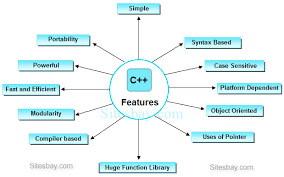
C++ combines the efficiency and manage of C with functions like classes, items, inheritance, and polymorphism, permitting builders to construct complex, scalable programs.
2. Key Features of C++
Object-Oriented: C++ supports object-orientated programming (OOP), which include encapsulation, inheritance, and polymorphism.
Compiled Language: Programs are compiled to machine code for overall performance and portability.
Platform Independent (with Compiler Support): Though not inherently platform-unbiased, C++ programs can run on a couple of structures when compiled therefore.
Low-Level Manipulation: Like C, C++ permits direct reminiscence get right of entry to thru suggestions.
Standard Template Library (STL): C++ consists of powerful libraries for facts systems and algorithms.
Rich Functionality: Supports functions like feature overloading, operator overloading, templates, and exception dealing with.
3. Structure of a C++ Program
Here’s a primary C++ program:
cpp
Copy
Edit
#encompass <iostream>
the use of namespace std;
int important()
cout << "Hello, World!" << endl;
return zero;
Explanation:
#encompass <iostream> consists of the enter/output stream library.
Using namespace std; allows using standard capabilities like cout without prefixing std::.
Foremost() is the access point of every C++ program.
Cout prints textual content to the console.
Four. Data Types and Variables
C++ has both primitive and user-defined statistics types. Examples:
cpp
Copy
Edit
int a = 10;
glide b = 3.14;
char c = 'A';
bool isReady = true;
Modifiers like short, lengthy, signed, and unsigned extend the information sorts’ range.
5. Operators
C++ supports, !
Assignment Operators: =, +=, -=, and many others.
Increment/Decrement: ++, --
Bitwise Operators: &,
cout << "a is greater";
else
cout << "b is extra";
Switch Case:
cpp
Copy
Edit
transfer (desire)
case 1: cout << "One"; ruin;
case 2: cout << "Two"; smash;
default: cout << "Other";
Loops:
For Loop:
cpp
Copy
Edit
for (int i = zero; i < five; i++)
cout << i << " ";
While Loop:
cpp
Copy
Edit
int i = 0;
at the same time as (i < five)
cout << i << " ";
i++;
Do-While Loop:
cpp
Copy
Edit
int i = zero;
do
cout << i << " ";
i++;
whilst (i < 5);
7. Functions
Functions in C++ growth modularity and reusability.
Cpp
Copy
Edit
int upload(int a, int b)
go back a + b;
int major()
cout << upload(three, 4);
return 0;
Functions may be overloaded via defining multiple variations with special parameters.
Eight. Object-Oriented Programming (OOP)
OOP is a chief energy of C++. It makes use of instructions and objects to represent real-international entities.
Class and Object Example:
cpp
Copy
Edit
magnificence Car
public:
string logo;
int pace;
void display()
cout << brand << " velocity: " << pace << " km/h" << endl;
int main()
Car myCar;
myCar.Emblem = "Toyota";
myCar.Pace = 120;
myCar.Show();
go back zero;
9. OOP Principles
1. Encapsulation:
Binding facts and features into a unmarried unit (elegance) and proscribing get admission to the usage of private, public, or blanketed.
2. Inheritance:
Allows one magnificence to inherit properties from another.
Cpp
Copy
Edit
elegance Animal
public:
void talk() cout << "Animal sound" << endl;
;
class Dog : public Animal
public:
void bark() cout << "Dog barks" << endl;
; three. Polymorphism:
Same characteristic behaves in a different way primarily based at the item or input.
Function Overloading: Same feature name, special parameters.
Function Overriding: Redefining base magnificence method in derived magnificence.
Four. Abstraction:
Hiding complicated information and showing handiest vital capabilities the usage of training and interfaces (abstract training).
10. Constructors and Destructors
Constructor: Special approach known as while an item is created.
Destructor: Called whilst an item is destroyed.
Cpp
Copy
Edit
magnificence Demo
public:
Demo()
cout << "Constructor calledn";
~Demo()
cout << "Destructor calledn";
;
11. Pointers and Dynamic Memory
C++ supports tips like C, and dynamic memory with new and delete.
Cpp
Copy
Edit
int* ptr = new int; // allocate reminiscence
*ptr = 5;
delete ptr; // deallocate memory
12. Arrays and Strings
cpp
Copy
Edit
int nums[5] = 1, 2, three, 4, 5;
cout << nums[2]; // prints 3
string name = "Alice";
cout << call.Period();
C++ also supports STL boxes like vector, map, set, and many others.
Thirteen. Standard Template Library (STL)
STL offers established training and features:
cpp
Copy
Edit
#consist of <vector>
#consist of <iostream>
using namespace std;
int important()
vector<int> v = 1, 2, 3;
v.Push_back(four);
for (int i : v)
cout << i << " ";
STL includes:
Containers: vector, list, set, map
Algorithms: sort, discover, rely
Iterators: for traversing containers
14. Exception Handling
cpp
Copy
Edit
attempt
int a = 10, b = 0;
if (b == zero) throw "Division by means of 0!";
cout << a / b;
seize (const char* msg)
cout << "Error: " << msg;
Use attempt, capture, and throw for managing runtime errors.
15. File Handling
cpp
Copy
Edit
#consist of <fstream>
ofstream out("information.Txt");
out << "Hello File";
out.Near();
ifstream in("records.Txt");
string line;
getline(in, line);
cout << line;
in.Near();
File I/O is achieved the usage of ifstream, ofstream, and fstream.
16. Applications of C++
Game Development: Unreal Engine is primarily based on C++.
System Software: Operating systems, compilers.
GUI Applications: Desktop software (e.G., Adobe merchandise).
Embedded Systems: Hardware-level applications.
Banking and Finance Software: High-speed buying and selling systems.
Real-Time Systems: Simulations, robotics, and so on.
17. Advantages of C++
Fast and efficient
Wide range of libraries
Suitable for each high-level and low-level programming
Strong item-orientated aid
Multi-paradigm: procedural + object-oriented
18. Limitations of C++
Manual reminiscence management can lead to mistakes
Lacks contemporary protection functions (in contrast to Java or Python)
Steeper studying curve for beginners
No built-in rubbish series
19. Modern C++ (C++11/14/17/20/23)
Modern C++ variations introduced capabilities like:
Smart recommendations (shared_ptr, unique_ptr)
Lambda expressions
Range-based totally for loops
car kind deduction
Multithreading support
Example:
cpp
Copy
Edit
vector<int> v = 1, 2, three;
for (auto x : v)
cout << x << " ";
C++ is a effective, high-overall performance programming language advanced as an extension of the C language. Created via Bjarne Stroustrup at Bell Labs in the early Eighties, C++ delivered object-orientated features to the procedural shape of C, making it appropriate for large-scale software program development. Over the years, it has emerge as a extensively used language for machine/software program improvement, game programming, embedded systems, real-time simulations, and extra.
C ++ Online Compliers
C++ combines the efficiency and manage of C with functions like classes, items, inheritance, and polymorphism, permitting builders to construct complex, scalable programs.
2. Key Features of C++
Object-Oriented: C++ supports object-orientated programming (OOP), which include encapsulation, inheritance, and polymorphism.
Compiled Language: Programs are compiled to machine code for overall performance and portability.
Platform Independent (with Compiler Support): Though not inherently platform-unbiased, C++ programs can run on a couple of structures when compiled therefore.
Low-Level Manipulation: Like C, C++ permits direct reminiscence get right of entry to thru suggestions.
Standard Template Library (STL): C++ consists of powerful libraries for facts systems and algorithms.
Rich Functionality: Supports functions like feature overloading, operator overloading, templates, and exception dealing with.
3. Structure of a C++ Program
Here’s a primary C++ program:
cpp
Copy
Edit
#encompass <iostream>
the use of namespace std;
int important()
cout << "Hello, World!" << endl;
return zero;
Explanation:
#encompass <iostream> consists of the enter/output stream library.
Using namespace std; allows using standard capabilities like cout without prefixing std::.
Foremost() is the access point of every C++ program.
Cout prints textual content to the console.
Four. Data Types and Variables
C++ has both primitive and user-defined statistics types. Examples:
cpp
Copy
Edit
int a = 10;
glide b = 3.14;
char c = 'A';
bool isReady = true;
Modifiers like short, lengthy, signed, and unsigned extend the information sorts’ range.
5. Operators
C++ supports, !
Assignment Operators: =, +=, -=, and many others.
Increment/Decrement: ++, --
Bitwise Operators: &,
cout << "a is greater";
else
cout << "b is extra";
Switch Case:
cpp
Copy
Edit
transfer (desire)
case 1: cout << "One"; ruin;
case 2: cout << "Two"; smash;
default: cout << "Other";
Loops:
For Loop:
cpp
Copy
Edit
for (int i = zero; i < five; i++)
cout << i << " ";
While Loop:
cpp
Copy
Edit
int i = 0;
at the same time as (i < five)
cout << i << " ";
i++;
Do-While Loop:
cpp
Copy
Edit
int i = zero;
do
cout << i << " ";
i++;
whilst (i < 5);
7. Functions
Functions in C++ growth modularity and reusability.
Cpp
Copy
Edit
int upload(int a, int b)
go back a + b;
int major()
cout << upload(three, 4);
return 0;
Functions may be overloaded via defining multiple variations with special parameters.
Eight. Object-Oriented Programming (OOP)
OOP is a chief energy of C++. It makes use of instructions and objects to represent real-international entities.
Class and Object Example:
cpp
Copy
Edit
magnificence Car
public:
string logo;
int pace;
void display()
cout << brand << " velocity: " << pace << " km/h" << endl;
int main()
Car myCar;
myCar.Emblem = "Toyota";
myCar.Pace = 120;
myCar.Show();
go back zero;
9. OOP Principles
1. Encapsulation:
Binding facts and features into a unmarried unit (elegance) and proscribing get admission to the usage of private, public, or blanketed.
2. Inheritance:
Allows one magnificence to inherit properties from another.
Cpp
Copy
Edit
elegance Animal
public:
void talk() cout << "Animal sound" << endl;
;
class Dog : public Animal
public:
void bark() cout << "Dog barks" << endl;
; three. Polymorphism:
Same characteristic behaves in a different way primarily based at the item or input.
Function Overloading: Same feature name, special parameters.
Function Overriding: Redefining base magnificence method in derived magnificence.
Four. Abstraction:
Hiding complicated information and showing handiest vital capabilities the usage of training and interfaces (abstract training).
10. Constructors and Destructors
Constructor: Special approach known as while an item is created.
Destructor: Called whilst an item is destroyed.
Cpp
Copy
Edit
magnificence Demo
public:
Demo()
cout << "Constructor calledn";
~Demo()
cout << "Destructor calledn";
;
11. Pointers and Dynamic Memory
C++ supports tips like C, and dynamic memory with new and delete.
Cpp
Copy
Edit
int* ptr = new int; // allocate reminiscence
*ptr = 5;
delete ptr; // deallocate memory
12. Arrays and Strings
cpp
Copy
Edit
int nums[5] = 1, 2, three, 4, 5;
cout << nums[2]; // prints 3
string name = "Alice";
cout << call.Period();
C++ also supports STL boxes like vector, map, set, and many others.
Thirteen. Standard Template Library (STL)
STL offers established training and features:
cpp
Copy
Edit
#consist of <vector>
#consist of <iostream>
using namespace std;
int important()
vector<int> v = 1, 2, 3;
v.Push_back(four);
for (int i : v)
cout << i << " ";
STL includes:
Containers: vector, list, set, map
Algorithms: sort, discover, rely
Iterators: for traversing containers
14. Exception Handling
cpp
Copy
Edit
attempt
int a = 10, b = 0;
if (b == zero) throw "Division by means of 0!";
cout << a / b;
seize (const char* msg)
cout << "Error: " << msg;
Use attempt, capture, and throw for managing runtime errors.
15. File Handling
cpp
Copy
Edit
#consist of <fstream>
ofstream out("information.Txt");
out << "Hello File";
out.Near();
ifstream in("records.Txt");
string line;
getline(in, line);
cout << line;
in.Near();
File I/O is achieved the usage of ifstream, ofstream, and fstream.
16. Applications of C++
Game Development: Unreal Engine is primarily based on C++.
System Software: Operating systems, compilers.
GUI Applications: Desktop software (e.G., Adobe merchandise).
Embedded Systems: Hardware-level applications.
Banking and Finance Software: High-speed buying and selling systems.
Real-Time Systems: Simulations, robotics, and so on.
17. Advantages of C++
Fast and efficient
Wide range of libraries
Suitable for each high-level and low-level programming
Strong item-orientated aid
Multi-paradigm: procedural + object-oriented
18. Limitations of C++
Manual reminiscence management can lead to mistakes
Lacks contemporary protection functions (in contrast to Java or Python)
Steeper studying curve for beginners
No built-in rubbish series
19. Modern C++ (C++11/14/17/20/23)
Modern C++ variations introduced capabilities like:
Smart recommendations (shared_ptr, unique_ptr)
Lambda expressions
Range-based totally for loops
car kind deduction
Multithreading support
Example:
cpp
Copy
Edit
vector<int> v = 1, 2, three;
for (auto x : v)
cout << x << " ";
C Lanugage Compliers
2 notes
·
View notes
Text
hey guys I know there's a lot of anti-trans shit but this one's from Georgia. they're calling it "the woman's rights bill".
I think there might actually be more, but this one caught my attention first. Basically it changes everything relating to gender in many bills to regard to biological sex specifically, and while that's worrying, it doesn't stop there. (it includes obviously making it very difficult to change your license or any kind of ID.)

(14) Laws, rules, and regulations that distinguish between the sexes are subject to intermediate constitutional scrutiny. Intermediate constitutional scrutiny forbids unfair discrimination against similarly situated male and female individuals but allows the law to distinguish between the sexes where such distinctions are substantially related to important governmental objections: and (15) Notwithstanding any provision of state law to the contrary, distinctions between the sexes with respect to athletics, living facilities, locker rooms, domestic violence shelters, rape crisis centers, restrooms, and other areas where biology, safety, or privacy are implicated that result in separate accommodations are substantially related to the important governmental objections of protecting the health, safety, and privacy of individuals in such circumstances.
basically, you could get in trouble for "sex discrimination" by not being in your biologically sorted bathroom, locker room, etc. this seems very easy to weaponize.

individuals in such circumstances. (c) Any local school system, or public school thereof, and any state agency, department, or political subdivision that collects vital statistics for the purpose of complying with antidiscrimination laws or for the purpose of gathering accurate public health, crime, economic, or other data shall identify each individual who is part of the collected data set as either male or female at birth."
pretty much any governmental place, specifically including public schools, can record your sex, that's information they're entitled to.

Title 17 of the Official Code of Georgia Annotated, relating to criminal procedure, is amended by revising subsection (a) of Code Section 17-4-20.2, relating to Bias Crime Report, requirements, use of reports, and publication, as follows: "(a) Whenever a law enforcement officer investigates an incident of a crime in which it appears that the defendant intentionally selected any victim or group of victims or any property as the object of the offense because of such victim's or group of victims' actual or perceived race, color, religion, national origin, sex, sexual orientation, gender, mental disability, or physical disability, whether or not an arrest is made, the officer shall prepare and submit to the law enforcement officer's supervisor or other designated person a written report of the incident entitled 'Bias Crime Report.' Forms for such reports shall be designed and provided by the Georgia Bureau of Investigation. The report shall include: (1) Names of the parties; (2) Relationship of the parties; (3) Sex and gender of the parties; (4) Race of the parties; (5) Religion of the parties;

SECTION 5. Said title is further amended by revising subsection (b) of Code Section 17-10-17, relating 107 to sentencing of defendants guilty of crimes involving bias or prejudice and identification of 108 increased sentenced, as follows: "(b) Subject to the notice requirement provided in Code Section 17-10-18 and in enhancement of the penalty imposed, if the trier of fact determines beyond a reasonable doubt that the defendant intentionally selected any victim or group of victims or any property as the object of the offense because of such victim's or group of victims' actual or perceived race, color, religion, national origin, sex, sexual orientation, gender, mental disability, or physical disability, the judge imposing sentence shall:
also, very worryingly, sexual orientation & gender are no longer included as reasons for a biased/prejudice crime investigation (aka a hate crime). yup. sexual orientation has been omitted here, not just sex/gender. how are you "lgb without the t" types feeling? it's not a hate crime anymore if you attack someone because they're gay, either, if this goes through.
I don't have a succinct call to action here, I just figure it's good to know. apparently they just.....all decided at once to try to push transphobic bills through.
15 notes
·
View notes
Text
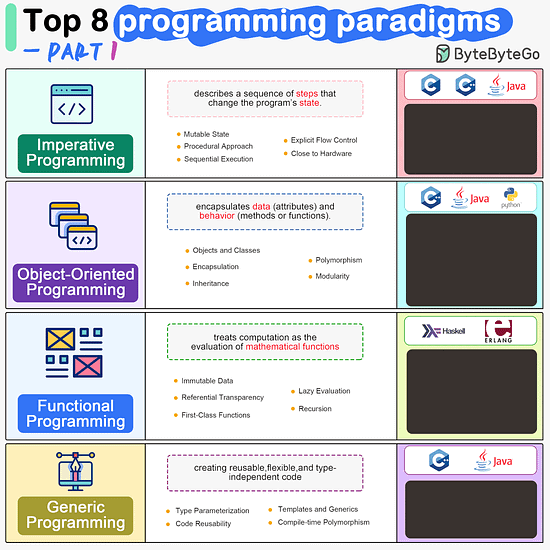
ByteByteGo | Newsletter/Blog
From the newsletter:
Imperative Programming Imperative programming describes a sequence of steps that change the program’s state. Languages like C, C++, Java, Python (to an extent), and many others support imperative programming styles.
Declarative Programming Declarative programming emphasizes expressing logic and functionalities without describing the control flow explicitly. Functional programming is a popular form of declarative programming.
Object-Oriented Programming (OOP) Object-oriented programming (OOP) revolves around the concept of objects, which encapsulate data (attributes) and behavior (methods or functions). Common object-oriented programming languages include Java, C++, Python, Ruby, and C#.
Aspect-Oriented Programming (AOP) Aspect-oriented programming (AOP) aims to modularize concerns that cut across multiple parts of a software system. AspectJ is one of the most well-known AOP frameworks that extends Java with AOP capabilities.
Functional Programming Functional Programming (FP) treats computation as the evaluation of mathematical functions and emphasizes the use of immutable data and declarative expressions. Languages like Haskell, Lisp, Erlang, and some features in languages like JavaScript, Python, and Scala support functional programming paradigms.
Reactive Programming Reactive Programming deals with asynchronous data streams and the propagation of changes. Event-driven applications, and streaming data processing applications benefit from reactive programming.
Generic Programming Generic Programming aims at creating reusable, flexible, and type-independent code by allowing algorithms and data structures to be written without specifying the types they will operate on. Generic programming is extensively used in libraries and frameworks to create data structures like lists, stacks, queues, and algorithms like sorting, searching.
Concurrent Programming Concurrent Programming deals with the execution of multiple tasks or processes simultaneously, improving performance and resource utilization. Concurrent programming is utilized in various applications, including multi-threaded servers, parallel processing, concurrent web servers, and high-performance computing.
#bytebytego#resource#programming#concurrent#generic#reactive#funtional#aspect#oriented#aop#fp#object#oop#declarative#imperative
8 notes
·
View notes
Text
Social market economy

Definition: What is a ‘social market economy’?
A social market economy is an economic system that is designed to combine competition with social objectives. The idea of a social market economy is strongly associated with Germany, where this economic system was implemented after the Second World War. The theoretical background is in particular ordoliberalism. From an economic ethics perspective, the ‘social’ in the social market economy does not constitute a supplementary or corrective measure to competition, but is intended to strengthen the latter's ability to function. This is achieved by designing social policy not against, but for the market, i.e. as insurance.
Economic order
1. Characterisation: Economic policy model conceived by Müller-Armack and Ludwig Erhard, which has been implemented in the Federal Republic of Germany since 1948. It takes up the demand of ordoliberalism (Freiburg School) for the state to guarantee a functioning competitive order, but supplements the catalogue of economic policy state tasks by emphasising socio-political goals. This model attempts to combine the goals and proposed solutions of liberalism, Christian social teaching and liberal socialism (opposite: communism). It is not a strictly self-contained concept, which means that the design mandate for the economic policy makers is more comprehensive and flexible than in ordoliberalism. The social market economy is more of an organisational concept that is open to social and ecological extensions or specifications.
2. Tasks/instruments: In addition to ensuring a liberal competitive order, a social orientation of economic policy is required. This concept is not primarily characterised as social by state redistribution of wealth or income opportunities, but rather it seeks a socio-politically motivated distribution of income growth, which is only made possible by a meaningful regulatory policy, as well as a socially oriented influence on market processes while ensuring that the instruments are market-compliant. Socially undesirable market outcomes are to be corrected by limiting or indirectly influencing private-sector initiative, while the social consequences of far-reaching structural upheavals are mitigated by means of state intervention. The ordoliberal thesis of the fundamental stability of the private sector is not fully shared and the necessity of a moderate state economic policy is derived from this. In the areas relevant to social policy where market failure is to be feared (e.g. social insurance systems), the state must intervene in a supportive manner, while upholding the principle of subsidiarity, or organise the provision of the relevant goods and services itself. Further tasks of the state are to pursue active labour market, wealth, housing and education policies, to ensure that corporate governance is socially responsible, and to provide the material and immaterial infrastructure necessary for socio-cultural and economic development.
3. Development: a) The first phase of the social market economy, from 1948 to 1966/7, is characterised by the dominance of ordoliberals. The Act against Restraints of Competition, the Federal Bank Act and the Collective Agreement Act, among others, fall within this period;
b) From 1966/7 (Stability and Growth Law) until the early 1980s, liberal socialism dominated, as expressed, for example, in the anti-cyclical fiscal policy and in the co-determination laws;
c) In the early 1980s, neoliberal ideas of a stable market economy (supply economics) were revived. Monetary policy was geared towards potential, and the aim was to achieve a cyclically neutral budget.
d) Since German reunification, the social market economy has been further developed with a greater focus on sustainability and affordability.
Science more or less
Business ethics
From an economic ethics perspective, the social market economy represents the best means yet known for realising social solidarity (Moralische Qualität der Marktwirtschaft). Two points represent a difference to widespread views:
(1) The ‘social’ in social market economy is not to be understood as a supplementary or corrective measure, but as a prerequisite of markets or the characterisation of the institutional arrangement as a whole; thus, social policy is not against, but for the market, i.e. to be conceived as insurance.
(2) Accordingly, the social market economy acquires its moral quality primarily from the coordination of markets, which fundamentally benefits all members of society, but not because of supposedly ‘social’ redistribution measures.
Or here the simple explanation for those for whom the above is too scientific.
social market economy
The state acts
Germany's economic system is the social market economy. It was developed from the free market economy. To prevent major social injustices from arising, the state intervenes in the free market economy where necessary. In doing so, the freedom of the market economy is restricted where it is anti-social, where it only serves the strong and harms the less strong.
Examples of how the social market economy works
There are, for example, laws governing protection against unfair dismissal, which forbid an employee from being dismissed from their job from one day to the next. This is important, because immediate dismissal would usually cause the employee major problems. Other laws are designed to prevent large companies from forming cartels. These cartels could fix the prices of their products in such a way that smaller companies could no longer keep up and go bankrupt. The state also ensures that employees are protected from major health and safety risks when performing dangerous work. And private property is protected. However, those who own property also have a responsibility for how they handle it.
Founders of the social market economy
The social market economy was developed after the Second World War by economics professors Alfred Müller-Armack and Ludwig Erhard. Their ideas are still valid today. Ludwig Erhard became the first Federal Minister for Economic Affairs after the founding of the Federal Republic of Germany in 1949 and later also Federal Chancellor.
Years of propaganda against a social state system like the social market economy have managed to persuade people that it would be socialism or even communism if the state intervened in the right way to prevent injustice.
Wikipedia more or less
When the subprime bubble burst, the capitalists did not mind being rescued by the state. Which is probably no different than socialism, or so the free market's motto went: let the market regulate itself.
Privatise profits and socialise losses was suddenly the order of the day.
mod

A responsible state creates a framework of conditions in which a catastrophe like the subprime crises cannot be generated.
The alleged self-regulation of the free market has proven to be a highly motivated lie throughout history, which is constantly being propagated by the owners.
Because if you tell a lie long enough, it becomes the truth.

Sorry, no. Capitalist systems must be regulated by the state in a reasonable way, otherwise chaos will reign again in the end, and the general public will have to pay for it.
mod



#social market economy#freedom of expression#equality#solution#save our democracy#galelry mod#wikipedia#subprime bubble#best Cartoons#equal rights#change the System#Casino World#Casino economy#workers rights#understanding#reality
5 notes
·
View notes